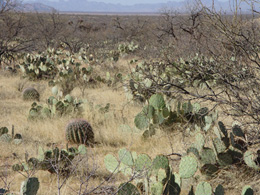cool-season drought and survival of warm-season perennial grasses
Extended drought is common in desert scrub and grassland communities of North American deserts. Precipitation in these environments occurs during the two rainy seasons per year. Summer (June-September) precipitation occurs in brief convective storms that may be separated by prolonged droughts. During the winter and spring, precipitation is usually from broad frontal storms of low intensity. A 2-4 month “foresummer” drought precedes the summer rainy season. A shorter drought period occurs in the autumn. Perennial plants in these environments must therefore cope with relatively short-term, but highly variable drought during rainy seasons, and more predictable and severe long-term drought during the foresummer and the autumn.
Native warm-season perennial grasses are considered keystone species on many desert scrub/grassland communities. Despite the critical roles played by these species, relatively little is known regarding the physiological, morphological, or genetical bases for drought survival of individual plants. Understanding the desiccation thresholds that result in mortality may permit more deterministic management and a more thorough appreciation of the consequences of environmental change. This exploratory project addresses these thresholds in Arizona cottontop (Digitaria californica), a panicoid bunchgrass that is native from central Mexico to southern and central Arizona and New Mexico, to north-central Texas. Arizona cottontop displays many traits associated with opportunistic response to soil moisture. Most notably, mature tillers may live for up to three years and when sufficient soil moisture is available, may rapidly produce leaves from long-lived axillary buds that are located throughout their length.
In this research we are addressing the following questions focusing on the period between mid-September and mid-July:
a) How does tiller moisture and axillary bud respiration generally change and how is this related to weather conditions?
b) What is the critical tissue moisture content for the survival of axillary buds?
Preliminary experiments in the field at the Santa Rita Experimental Range have shown that even during extended (> 80-day) cool-season drought, internodes on mature tillers contain sufficient moisture to continue respiring (Figure 1). Leaf growth early in the springtime may act to rehydrate tillers. Using plants grown in 38-L containers in a rainout shelter in Tucson has also shown that respiration in and around axillary buds ceases when absolute tissue moisture falls below about 15%. Mortality occurs basipetally within a tiller during the foresummer drought. We are very interested in determining whether moisture status at various points during springtime drought can be used to predict eventual plant growth and forage production when precipiation occurs during mid-summer. Ultimately, we are interested in how natural selection may affect Arizona cottontop populations in response to extreme cool-season drought events.



